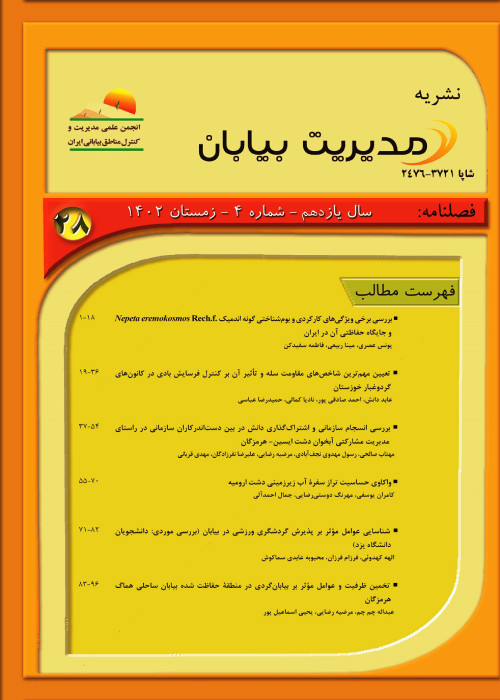Analysis of Desertification Potential of Yazd Province Using DVI Indicators
One of the environmental challenges in the world is desertification. Desertification is land degradation in arid, semi-arid and dry sub-humid caused by several factors such as climate change and human activities. Desertification is a significant phenomenon, particularly in arid and semi-arid regions. In many instances, it is seen as a serious threat to human societies. The desertification process in developing countries is very intense, and this issue can have a significant impact on the future of these countries. Iran is a country that is exposed to the phenomenon of desertification. Due to the geographical location, arid and semi-arid areas cover approximately two-thirds of Iran. The desertification phenomenon is present in Yazd province. Due to its climate and hydrogeomorphology, this province, which is located in the central regions of Iran, has a high vulnerability potential against land use changes and desertification. Considering the importance of the topic, this research has identified the vulnerable areas of Yazd province against desertification using the DVI index.
In this research, library information, statistical data related to the population of Yazd province, climatic data of Yazd province, as well as the 30-meter SRTM DEM as the most important research data were used. The model used in this research was based on DVI vulnerability index. The DVI vulnerability index was the basis for the model used in this research. The time-spatial changes of vulnerability to desertification in the Banas River basin in India have been investigated using the DVI model. The DVI model uses 9 indicators, which are grouped into 4 groups: demographic indicators, weather indicators, topographic indicators, and soil indicators.
In this research, in order to identify the vulnerable areas of Yazd province to desertification from demographic indicators (population density, population growth and illiteracy percentage), weather indicators (precipitation rate, average temperature, and evaporation rate and dryness index), topographic indices (slope percentage) and soil science indices (soil type) have been used.The slope index indicates that the western parts of Yazd province are more vulnerable. According to the geological index, the northern and eastern parts of this province are highly vulnerable. The northern, central, and eastern regions of Yazd province are highly vulnerable in terms of precipitation, average temperature, evaporation, and dryness indicators. Yazd city has a high vulnerability potential in terms of population density index. In terms of population growth index, Ardakan city has a high vulnerability potential and also in terms of illiteracy index, Taft city has a high vulnerability potential. The location of Yazd province has resulted in a large portion of its area being covered in arid and hyper-arid areas. Due to their high vulnerability to erosion, destruction, and vulnerability, many parts of this province are prone to desertification. The DVI model was used to evaluate the vulnerability potential of Yazd province against desertification in this research. The DVI model results are divided into 4 vulnerability potential classes: low, medium, high, and very high. The results indicate that the class with a high vulnerability potential covers 42.9% of the area, which is primarily concentrated in the northern and central areas of Yazd province. The class with high vulnerability potential covers 41/4 of the area, which primarily encompasses the western regions of Yazd province. The classes with medium and low vulnerability potential are distributed in the central, southeastern, and southern parts of Yazd province, with 14.3 and 1.4 percent of the area, respectively. The vulnerability status of cities in Yazd province has been assessed in this research. Khatam and Bahabad cities have the lowest vulnerability percentage, while Yazd, Meibod, and Ardakan cities have the highest vulnerability potential, according to the results. Many parts of Yazd province, including its northern and central regions, have a high vulnerability potential, which requires special attention and the implementation of long-term programs to prevent vulnerability and increase desertification.
- حق عضویت دریافتی صرف حمایت از نشریات عضو و نگهداری، تکمیل و توسعه مگیران میشود.
- پرداخت حق اشتراک و دانلود مقالات اجازه بازنشر آن در سایر رسانههای چاپی و دیجیتال را به کاربر نمیدهد.



